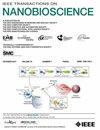Adsorption of Brilliant Green Dye by Iron Oxide Nanoparticles Synthesized From the Leaf Extracts of Acacia jacquemontii
IF 4.4
4区 生物学
Q1 BIOCHEMICAL RESEARCH METHODS
引用次数: 0
Abstract
Phyto-mediated synthesis can be used for the sustainable fabrication of metallic nanoparticles (NPs). Ethanolic leaf extract of Acacia jacquemontii was used to phyto-fabricate iron oxide nanoparticles (FeO NPs). Synthesized FeO NPs were examined by various analytical techniques for their detailed chemical elemental and morphological features. High-performance thin-layer chromatography (HPTLC) was used for the analysis of the ethanolic extracts of the leaves, which ensured the presence of phenols and terpenoids in the extract. FeO NPs show a peak between 350-400nm when analyzed by UV-Vis spectroscopy, and the typical bands were found in the range of 745 cm−1 for Fe-O and 1595 cm−1, 3177 cm−1 for some other organic molecules by Fourier transform-infrared (FTIR). The spherical shape of FeO NPs was investigated with the help of a Field emission scanning electron microscope (FESEM) analysis which exhibited the size varied from 13.35 to 31.29 nm. Electron diffraction spectroscopy (EDS) confirmed the Fe, O, and C peaks, along with N, Cl, S, and K traces. The adsorption capacity of the FeO NPs for brilliant green (BG) dye was evaluated at different pH, dosages of adsorbent, and contact time. The highest adsorption parentage of 57.2% for 10 ppm BG dye was observed at 9 pH and 10 mg doses of FeO NPs. The highest absorption capacity of FeO NPs is 60 mg/g. The recyclability potential of the FeO NPs continuously decreased with the repletion of the cycle from first to fourth whose value reached 19.33% after the fourth cycle. Such phytofabricated FeO NPs and their application in the removal of organic could prove to be eco-friendly and economical.用金合欢叶提取物合成的氧化铁纳米颗粒对亮绿色染料的吸附。
植物介导合成可用于金属纳米颗粒的可持续制造。以金合欢叶乙醇提取物为原料,制备了氧化铁纳米颗粒。用各种分析技术对合成的FeO NPs进行了详细的化学元素和形态特征检测。采用高效薄层色谱法(HPTLC)对乙醇提取物进行分析,确保提取物中存在酚类和萜类物质。傅里叶变换红外(FTIR)分析发现,FeO NPs的典型谱带在350 ~ 400nm之间,Fe-O的谱带在745 cm-1范围内,其他有机分子的谱带在1595 cm-1、3177 cm-1范围内。利用场发射扫描电镜(FESEM)分析了FeO纳米颗粒的球形形状,其尺寸在13.35 ~ 31.29 nm之间。电子衍射谱(EDS)证实了Fe, O和C峰,以及N, Cl, S和K的痕迹。考察了FeO NPs在不同pH、吸附剂用量和接触时间下对亮绿染料的吸附能力。在9 pH和10 mg FeO NPs剂量下,10 ppm BG染料的最高吸附率为57.2%。FeO NPs的最高吸收容量为60 mg/g。FeO NPs的可回收潜力随循环次数从第1次到第4次不断降低,第4次循环后达到19.33%。这种植物合成的FeO NPs及其在有机物去除中的应用可能被证明是生态友好和经济的。
本文章由计算机程序翻译,如有差异,请以英文原文为准。
求助全文
约1分钟内获得全文
求助全文
来源期刊

IEEE Transactions on NanoBioscience
工程技术-纳米科技
CiteScore
7.00
自引率
5.10%
发文量
197
审稿时长
>12 weeks
期刊介绍:
The IEEE Transactions on NanoBioscience reports on original, innovative and interdisciplinary work on all aspects of molecular systems, cellular systems, and tissues (including molecular electronics). Topics covered in the journal focus on a broad spectrum of aspects, both on foundations and on applications. Specifically, methods and techniques, experimental aspects, design and implementation, instrumentation and laboratory equipment, clinical aspects, hardware and software data acquisition and analysis and computer based modelling are covered (based on traditional or high performance computing - parallel computers or computer networks).
 求助内容:
求助内容: 应助结果提醒方式:
应助结果提醒方式:


